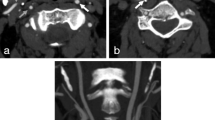Abstract
The aim of this study was to investigate CT angiography (CTA) luminal area measurements in the assessment of carotid artery stenosis compared with the current clinically used criteria based on lumen diameter measurements. Seventy-two vessels in 36 patients were evaluated by CTA and digital subtraction angiography (DSA). Two observers measured area and diameter stenosis degrees using automated 3D CTA analysis software. The ratio of the largest/smallest luminal diameter at the level of maximal stenosis (L/S ratio) was used to describe lumen morphology. Diagnostic agreement between CTA and DSA was calculated. For the assessment of area stenosis, interobserver and intraobserver correlation coefficients were 0.898 and 0.906 (p<0.001). The correlation coefficient between the diameter stenosis and area stenosis was lower in stenoses with extremely noncircular lumen (L/S ratio ≥1.5) (r=0.797, p<0.001) compared with stenoses with circular lumen (LS ratio <1.2) (r=0.978, p<0.001). Only satisfactory agreement (κ 0.54-0.77, p<0.001) was obtained between area stenosis on CTA and diameter stenosis on DSA. Assessment of stenosis degree with area measurements on 3D CTA proved to be reproducible. Area stenosis provides a less-severe estimate of the degree of carotid stenosis but might theoretically express the real hemodynamic significance of the lesion better than diameter stenosis, especially in stenoses with noncircular lumen.



Similar content being viewed by others
References
(1991) Beneficial effect of carotid endarterectomy in symptomatic patients with high-grade carotid stenosis. North American Symptomatic Carotid Endarterectomy Trial Collaborators. N Engl J Med 325:445–453
Rothwell PM, Gibson RJ, Slattery J, Sellar RJ, Warlow CP (1994) Equivalence of measurements of carotid stenosis. A comparison of three methods on 1001 angiograms. European Carotid Surgery Trialists’ Collaborative Group. Stroke 25:2435–2439
Young GR, Humphrey PR, Nixon TE, Smith ET (1996) Variability in measurement of extracranial internal carotid artery stenosis as displayed by both digital subtraction and magnetic resonance angiography: an assessment of three caliper techniques and visual impression of stenosis. Stroke 27:467–473
Elgersma OE, Buijs PC, Wust AF, van der Graaf Y, Eikelboom BC, Mali WP (1999) Maximum internal carotid arterial stenosis: assessment with rotational angiography versus conventional intraarterial digital subtraction angiography. Radiology 213:777–783
Hirai T, Korogi Y, Ono K, Murata Y, Takahashi M, Suginohara K, Uemura S (2001) Maximum stenosis of extracranial internal carotid artery: effect of luminal morphology on stenosis measurement by using CT angiography and conventional DSA. Radiology 221:802–809
Zhang Z, Berg MH, Ikonen AE, Vanninen RL, Manninen HI (2003) Carotid artery stenosis: reproducibility of automated 3D CT angiography analysis method. Eur Radiol 14:665–672
Ito K, Yamagishi M, Yasumura Y, Nakatani S, Yasuda S, Miyatake K (1999) Impact of coronary artery remodeling on misinterpretation of angiographic disease eccentricity: evidence from intravascular ultrasound. Int J Cardiol 70:275–282
Ito K, Higashikata T, Hanatani A, Yasumura Y, Nagaya N, Yasuda S, Otsuka Y, Nakatani S, Yamagishi M (2002) Effect of disease eccentricity on compensatory remodeling of coronary arteries: evidence from intravascular ultrasound before interventions. Int J Cardiol 86:99–105
Maehara A, Mintz GS, Castagna MT, Pichard AD, Satler LF, Waksman R, Suddath WO, Kent KM, Weissman NJ (2002) Intravascular ultrasound assessment of spontaneous coronary artery dissection. Am J Cardiol 89:466–468
Cinat M, Lane CT, Pham H, Lee A, Wilson SE, Gordon I (1998) Helical CT angiography in the preoperative evaluation of carotid artery stenosis. J Vasc Surg 28:290–300
(1998) Randomised trial of endarterectomy for recently symptomatic carotid stenosis: final results of the MRC European Carotid Surgery Trial (ECST) [see comments]. Lancet 351:1379–1387
Rothwell PM, Eliasziw M, Gutnikov SA, Fox AJ, Taylor DW, Mayberg MR, Warlow CP, Barnett HJ (2003) Analysis of pooled data from the randomised controlled trials of endarterectomy for symptomatic carotid stenosis. Lancet 361:107–116
Anderson CM, Lee RE, Levin DL, de la Torre Alonso S, Saloner D (1994) Measurement of internal carotid artery stenosis from source MR angiograms. Radiology 193:219–226
Fahrig R, Fox AJ, Lownie S, Holdsworth DW (1997) Use of a C-arm system to generate true three-dimensional computed rotational angiograms: preliminary in vitro and in vivo results. AJNR Am J Neuroradiol 18:1507–1514
Nissen SE, Yock P (2001) Intravascular ultrasound: novel pathophysiological insights and current clinical applications. Circulation 103:604–616
Acknowledgements
This work was supported by a grant from Kuopio University Hospital (grant number 5063501).
Author information
Authors and Affiliations
Corresponding author
Appendix
Appendix
1. The theoretical (standard) equation between area stenosis and where r2: radius of reference area; r1: radius of maximal stenosis area; A: area stenosis degree; N: diameter stenosis degree.
The equation A=2N-N2 is valid when carotid lumens are circular in shape (L/S ratio=1.0) both at the level of maximal stenosis and at the level of reference. Thus for 70%, 50%, and 30% diameter stenosis, the corresponding area stenosis values are 91%, 75%, and 51%, respectively.
2. The regression curve between area stenosis and diameter stenosis by 3D AVA in this study:
Rights and permissions
About this article
Cite this article
Zhang, Z., Berg, M., Ikonen, A. et al. Carotid stenosis degree in CT angiography: assessment based on luminal area versus luminal diameter measurements. Eur Radiol 15, 2359–2365 (2005). https://doi.org/10.1007/s00330-005-2801-2
Received:
Revised:
Accepted:
Published:
Issue Date:
DOI: https://doi.org/10.1007/s00330-005-2801-2




